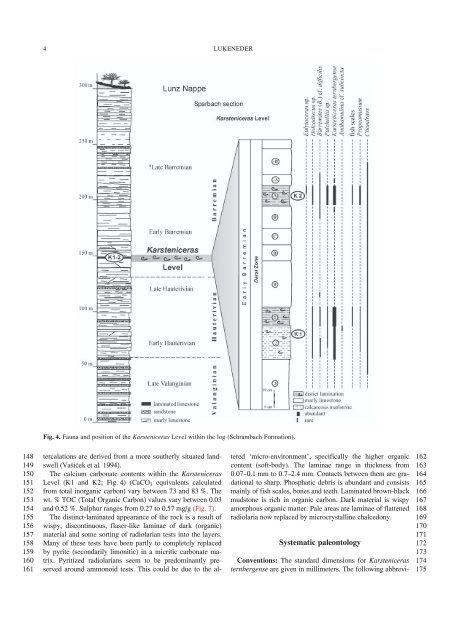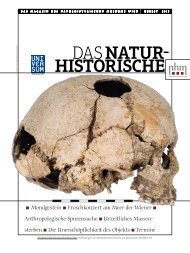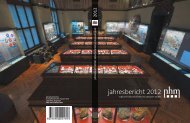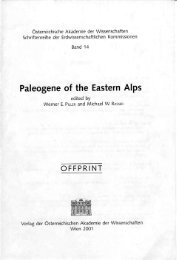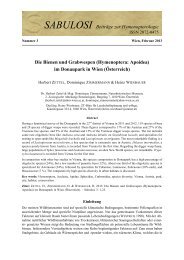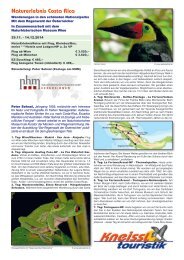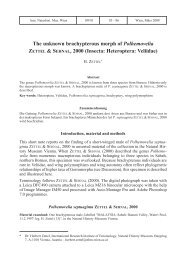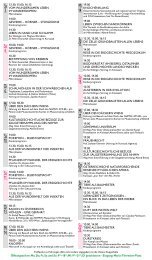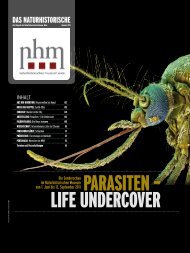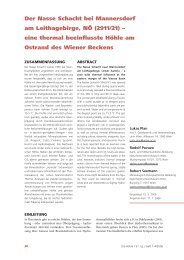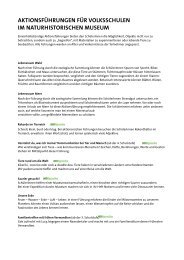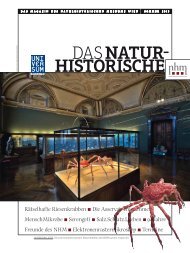Lukeneder pdf - Naturhistorisches Museum Wien
Lukeneder pdf - Naturhistorisches Museum Wien
Lukeneder pdf - Naturhistorisches Museum Wien
Create successful ePaper yourself
Turn your PDF publications into a flip-book with our unique Google optimized e-Paper software.
148<br />
149<br />
150<br />
151<br />
152<br />
153<br />
154<br />
155<br />
156<br />
157<br />
158<br />
159<br />
160<br />
161<br />
4 LUKENEDER<br />
Article in Proof<br />
�ig. 4. �auna and position of the Karsteniceras Level within the log (Schrambach �ormation).<br />
tercalations are derived from a more southerly situated landswell<br />
(Vašíèek et al. 1994).<br />
The calcium carbonate contents within the Karsteniceras<br />
Level (K1 and K2; �ig. 4) (CaCO 3 equivalents calculated<br />
from total inorganic carbon) vary between 73 and 83 %. The<br />
wt. % TOC (Total Organic Carbon) values vary between 0.03<br />
and 0.52 %. Sulphur ranges from 0.27 to 0.57 mg/g (�ig. 7).<br />
The distinct-laminated appearance of the rock is a result of<br />
wispy, discontinuous, flaser-like laminae of dark (organic)<br />
material and some sorting of radiolarian tests into the layers.<br />
Many of these tests have been partly to completely replaced<br />
by pyrite (secondarily limonitic) in a micritic carbonate matrix.<br />
Pyritized radiolarians seem to be predominantly preserved<br />
around ammonoid tests. This could be due to the al-<br />
tered ‘micro-environment’, specifically the higher organic<br />
content (soft-body). The laminae range in thickness from<br />
0.07–0.1 mm to 0.7–2.4 mm. Contacts between them are gradational<br />
to sharp. Phosphatic debris is abundant and consists<br />
mainly of fish scales, bones and teeth. Laminated brown-black<br />
mudstone is rich in organic carbon. Dark material is wispy<br />
amorphous organic matter. Pale areas are laminae of flattened<br />
radiolaria now replaced by microcrystalline chalcedony.<br />
Systematic paleontology<br />
Conventions: The standard dimensions for Karsteniceras<br />
ternbergense are given in millimeters. The following abbrevi-<br />
162<br />
163<br />
164<br />
165<br />
166<br />
167<br />
168<br />
169<br />
170<br />
171<br />
172<br />
173<br />
174<br />
175


